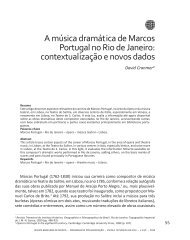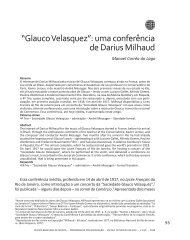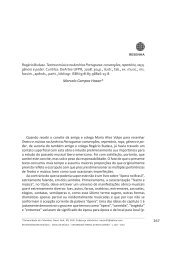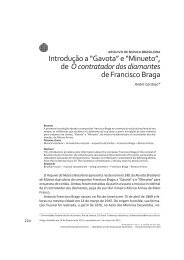Versão Digital - UFRJ
Versão Digital - UFRJ
Versão Digital - UFRJ
Create successful ePaper yourself
Turn your PDF publications into a flip-book with our unique Google optimized e-Paper software.
24<br />
That is why collections outside Italy have proven so important. The archives of<br />
the Marinsky theater in St. Petersburg is one important location. Another is the Paris<br />
Opéra, which has always had a saving mentality (in English we talk about “pack rats” as<br />
saving everything, so that it is still possible today to examine performing materials from<br />
operas that were given at the Opéra from the eighteenth century and the nineteenth<br />
centuries. For some operas, such as Le comte Ory, for which practically no autograph<br />
manuscripts exist, the new critical edition of the opera depends on the original performing<br />
materials (especially on a score prepared by copyists at the Opéra, but also on the early<br />
performing parts, which must be carefully differentiated from later materials). 24 The same<br />
was true for Guillaume Tell and it will undoubtedly be true for the other operas by Rossini<br />
written for the Paris Opéra. For the Donizetti and Verdi operas prepared for the Opéra, we<br />
have – by and large – the original autograph manuscripts, so the materials at the Opéra´have<br />
slightly less importance, but they nonetheless continue to answer many questions that<br />
the autograph manuscripts leave unanswered (what some of these are I will discuss in a<br />
few moments).<br />
The scholar M. Elizabeth C. Bartlet, who died tragically of breast cancer a few<br />
years ago, knew more about French archives than anyone else in the world. She herself<br />
did critical editions of Jean-Philippe Rameau’s Platée and Rossini’s Guillaume Tell. 25 She<br />
also was certain that materials must have still existed from the archives of the Opéracomique<br />
and the Théâtre Italien, despite the fire that consumed much of the Italian theater<br />
in 1837. Beth, who was a very strong and persistent scholar, made such a pain-in-the-neck<br />
of herself during the 1970s that the staff of the Bibliothèque Nationale, Départment de la<br />
Musique, finally allowed her access to uncatalogued parts of the collection. It was there<br />
that Dr. Bartlet discovered the performing materials pertaining to Rossini’s Il viaggio a<br />
Reims, the first traces we had seen for this unknown and unpublished opera. From her<br />
discoveries, the effort to reconstruct that masterpiece of Rossini’s maturity took wing. 26<br />
Another significant collection of this kind existed for many years in the archives<br />
of Covent Garden in London. Although the theater often insisted that they had nothing, it<br />
wasn’t true: they had a remarkable collection of performing materials, now deposited at<br />
the British Library. The person who particularly insisted that these be made public was<br />
Will Crutchfield, who found important original Donizetti manuscripts in the archive. But<br />
the original performing parts of Verdi’s I masnadieri, which had its first performance at<br />
Covent Garden, were used extensively by Roberta Marvin when she prepared the critical<br />
edition of that opera. These parts showed, for example, that the original prima donna,<br />
Jenny Lind, ornamented the repetition of the cabaletta theme so extensively that it was<br />
necessary to cancel Verdi’s instrumental parts doubling the melody for that repetition.<br />
Since the opera had been performed at Covent Garden only in that original season, there<br />
was no question about the proper dating of these annotations. 27<br />
Still, with all of these discoveries, nothing prepared me for what I would find in<br />
the conservatory library at Rio de Janeiro. Although some of the materials do come from<br />
...........................................................................<br />
24 This edition is being prepared by Damien Colas for Works of Gioachino Rossini (Bärenreiter-Verlag: Kassel,<br />
etc., in preparation). It is hoped that the Colas edition, which has already been successfully performed in Zürich,<br />
with Cecilia Bartoli as the Comtesse Adele, will be in print before the end of 2011.<br />
25 The editions appeared, respectively, in the Opera Omnia of Jean-Philipp Rameau, Series 4, vol. 10 (Bonneuil-<br />
Matours, Socieìteì Jean-Philippe Rameau: France, 2005) and the Edizione critica delle opere di Gioachino Rossini,<br />
Series I, vol. 39 (Fondazione Rossini: Pesaro, 1992).<br />
26 For further information about the discovery and reconstruction of Il viaggio a Reims, see Divas and Scholars,<br />
152-8. A critical edition of the opera, Janet Johnson, ed., was published as Series I, vol. 35 in the Edizione critica<br />
delle opere di Gioachino Rossini (Fondazione Rossini: Pesaro, 1999).<br />
27 This history is described in the Preface to the critical edition of I masnadieri, Roberta Montemorra Marvin, ed.<br />
(see Note 9).<br />
Atualidade da Ópera - Série Simpósio Internacional de Musicologia da <strong>UFRJ</strong>






